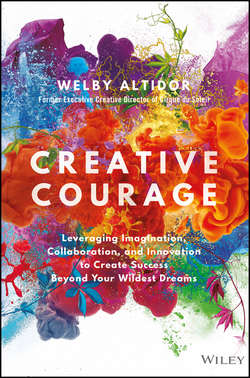Читать книгу Creative Courage - Altidor Welby - Страница 8
На сайте Литреса книга снята с продажи.
PREFACE
ОглавлениеI believe that a work culture that supports the growth of its employees creates more favorable conditions for its brand, its products, its services to be and stay relevant. Our well-being, our ability to lead efficiently and creatively, is connected to the quality of our culture at work. That culture can suffer from the tension between the status quo and the need for transformation. In fact, in every culture, we find forces aimed at preserving the status quo and opposing energies dedicated to its transformation.
In that potential conflict sits the promise of creativity, innovation, and breakthroughs. Finding the harmony between these two necessary forces is not easy, and when one force takes over too radically or disruptively, the other force likely reacts. When the status quo tries to impose itself resolutely, the war on imagination lives strong, as a state of conflict where imagination, free association of ideas and the connection of unrelated concepts, or diverse teams and people is strongly discouraged, even punished. In other words, when the status quo takes over, the war on imagination follows. When the energy of transformation goes too fast for the people it affects, we are left with incomprehension, anger, and reactionary retraction from the world. We step back into our identities and our politics when at work. I call these moments in organizations, brand grabs. We hold on to a less than optimal, often nostalgic vision of who we are.
The distress between status quo and transformation stems from obvious and obscure reasons. The dramatic advances in computing and one of its by-products, quicker, more voluminous disseminations of information, is one factor in the worsening of the dynamic and coupling between what's stable and what's transforming. This situation challenges almost everything in our world, from the way we call a taxi, think about mobility and transportation, to the way that we will consume entertainment in the future.
Consequently, becoming relevant and staying relevant has become harder for organizations and brands. As the newest rapidly replaces the new, the pressure on the bottom line expands, and the need to innovate grows faster while the cycles of discoveries stay practically unchanged. We know that we need to evolve by staying agile and nimble. But we also don't want to lose our identity, our culture, I hear leaders say.
So how can we create or nurture a more innovative culture at work to answer the call of transformation? How can we leverage imagination and creativity to make our work more robust and resilient? And how can such a culture help produce relevance inside and outside our organization? Moreover, and more fundamentally, as we face those challenges, do we have to choose between a high-performance culture that helps generate great value at a very high human cost, or a nurturing culture that sacrifices value, innovation and performance for the integrity of the life inside all of us? De we have to choose between value and values?
I believe that we can bridge the gap between value and values, between high-performance and nurturing space for meaningful work. By learning to lead with creative courage, we can help create a culture for our organization that's more innovative and more able to answer the call of transformation. At its core, the practice of leading with creative courage offers an evolving and open cycle of seven integrated, incremental practices: (1) care first, (2) secure safety, (3) foster trust, (4) play with danger, (5) dream, (6) discover breakthroughs, (7) and grow. Under the umbrella of creative courage, these practices that I also refer to as stages or dimensions offer a powerful framework that you can adapt to your reality as you help yourself and your organization transform while staying true to your most important principles. Leading with creative courage offers support on the path to inside-out relevance for you and your organization.
